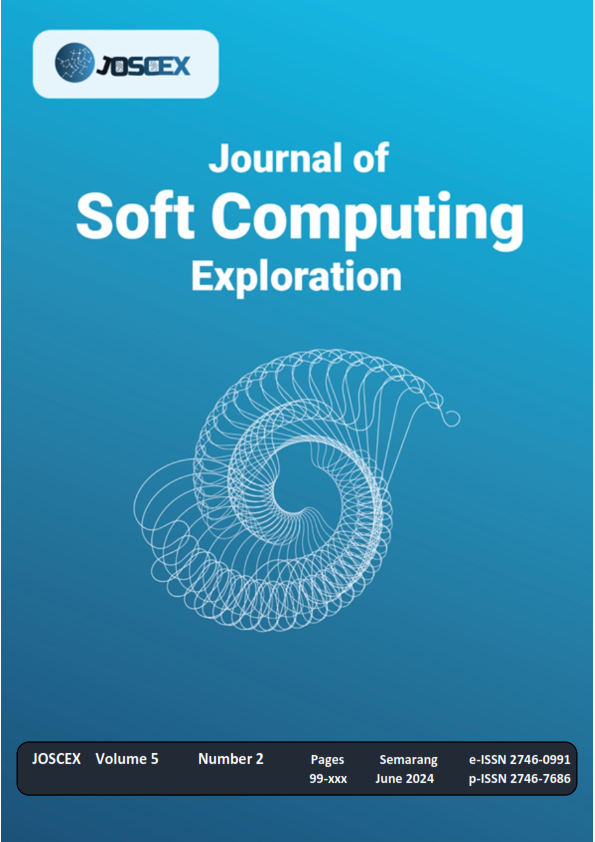Breast tumor classification using adam and optuna model optimization based on CNN architecture
Main Article Content
Abstract
Breast cancer presents a significant challenge due to its complexity and the urgency of the intervention required to prevent metastasis and potential fatality. This article highlights the innovative application of Convolutional Neural Networks (CNN) in breast tumor classification, marking substantial progress in the field. The key to this advancement is the collaboration among medical professionals, scientists, and artificial intelligence experts, which maximizes the potential of technology. The research involved three phases of training with varying proportions of training data. The first training phase achieved the highest accuracy rate of 99.72%, with an average accuracy of 99.05% in all three phases. Metrics such as precision, recall, and F1 score were also highly satisfactory, underscoring the model's efficacy in accurately classifying breast tumors. Future research aims to develop more complex and precise predictive models by incorporating larger and more representative datasets. This progression promises to improve understanding, prevention, and management of breast cancer, offering hope for significant advances in 2024 and beyond.
Downloads
Article Details

This work is licensed under a Creative Commons Attribution-ShareAlike 4.0 International License.
References
“Breast cancer.” Accessed: Sep. 25, 2023. [Online]. Available: https://www.who.int/news-room/fact-sheets/detail/breast-cancer
M. Usman and I. Almas, “Psycho-Social Impact of Breast Cancer on Women A Case Study of the Urban Areas of Lahore,” 2022. [Online]. Available: http://journal.mgp.org.pk/index.php/MJSSM
O. Amato, V. Guarneri, and F. Girardi, “Epidemiology trends and progress in breast cancer survival: earlier diagnosis, new therapeutics,” Curr Opin Oncol, Sep. 2023, doi: 10.1097/CCO.0000000000000991.
S. Mubarik et al., “Estimating disparities in breast cancer screening programs towards mortality, case fatality, and DALYs across BRICS-plus,” BMC Med, vol. 21, no. 1, p. 299, Dec. 2023, doi: 10.1186/s12916-023-03004-4.
M. M. Srikantamurthy, V. P. S. Rallabandi, D. B. Dudekula, S. Natarajan, and J. Park, “Classification of benign and malignant subtypes of breast cancer histopathology imaging using hybrid CNN-LSTM based transfer learning,” BMC Med Imaging, vol. 23, no. 1, Dec. 2023, doi: 10.1186/s12880-023-00964-0.
N. A. Samee, G. Atteia, S. Meshoul, M. A. Al-antari, and Y. M. Kadah, “Deep Learning Cascaded Feature Selection Framework for Breast Cancer Classification: Hybrid CNN with Univariate-Based Approach,” Mathematics, vol. 10, no. 19, Oct. 2022, doi: 10.3390/math10193631.
Y. Alqahtani, U. Mandawkar, A. Sharma, M. N. S. Hasan, M. H. Kulkarni, and R. Sugumar, “Breast Cancer Pathological Image Classification Based on the Multiscale CNN Squeeze Model,” Comput Intell Neurosci, vol. 2022, 2022, doi: 10.1155/2022/7075408.
R. K. Pathan et al., “Breast Cancer Classification by Using Multi-Headed Convolutional Neural Network Modeling,” Healthcare (Switzerland), vol. 10, no. 12, Dec. 2022, doi: 10.3390/healthcare10122367.
S. Mohapatra, S. Muduly, S. Mohanty, J. V. R. Ravindra, and S. N. Mohanty, “Evaluation of deep learning models for detecting breast cancer using histopathological mammograms Images,” Sustainable Operations and Computers, vol. 3, pp. 296–302, Jan. 2022, doi: 10.1016/j.susoc.2022.06.001.
Y. Fredyatama, Z. Abidin, and P. Informatika Sekolah Tinggi Teknik Pati, “Jurnal EDUKASI ELEKTROMATIKA (JEE) CLASSIFICATION FEASIBILITY OF BLOOD THAT CAN BE DONORED USING K-NN WITH K-MEANS OPTIMIZATION KLASIFIKASI KELAYAKAN DARAH YANG DAPAT DIDONORKAN MENGGUNAKAN K-NN DENGAN OPTIMASI K-MEANS,” JURNAL EDUKASI ELEKTROMATIKA, vol. 4, no. 1, 2023.
M. Trombini, D. Solarna, G. Moser, and S. Dellepiane, “A goal-driven unsupervised image segmentation method combining graph-based processing and Markov random fields,” Pattern Recognit, vol. 134, Feb. 2023, doi: 10.1016/j.patcog.2022.109082.
D. M. Mahalakshmi and S. Sumathi, “BRAIN TUMOUR SEGMENTATION STRATEGIES UTILIZING MEAN SHIFT CLUSTERING AND CONTENT BASED ACTIVE CONTOUR SEGMENTATION,” ICTACT Journal on Image and Video Processing, vol. 9, no. 4, pp. 2002–2008, May 2019, doi: 10.21917/ijivp.2019.0284.
N. T. Tsanya, A. N. Wardana, and N. Effendy, “Deteksi Osilasi Kontrol pada Proses Industri dengan Menggunakan Jaringan Saraf Tiruan-Review,” 2022. [Online]. Available: https://jurnaleeccis.ub.ac.id/
J. I. Dyah Prabandari, C. A. Sari, E. H. Rachmawanto, C. Irawan, B. R. Altamer, and M. Ayad Alkhafaji, “Early Detection and Classification of Melanoma Based on Android MobileNet V2 Convolutional Neural Network,” in 2023 International Seminar on Application for Technology of Information and Communication (iSemantic), IEEE, Sep. 2023, pp. 400–405. doi: 10.1109/iSemantic59612.2023.10295362.
A. Molaei et al., “Implicit Neural Representation in Medical Imaging: A Comparative Survey,” Jul. 2023, [Online]. Available: http://arxiv.org/abs/2307.16142
V. Praskatama, C. A. Sari, E. H. Rachmawanto, and N. Mohd Yaacob, “PNEUMONIA PREDICTION USING CONVOLUTIONAL NEURAL NETWORK,” Jurnal Teknik Informatika (Jutif), vol. 4, no. 5, pp. 1217–1226, Oct. 2023, doi: 10.52436/1.jutif.2023.4.5.1353.
E. H. Rachmawanto, C. A. Sari, and F. O. Isinkaye, “A good result of brain tumor classification based on simple convolutional neural network architecture,” Telkomnika (Telecommunication Computing Electronics and Control), vol. 22, no. 3, pp. 711–719, Jun. 2024, doi: 10.12928/TELKOMNIKA.v22i3.25863.
A. A. Amadea, C. A. Sari, E. H. Rachmawanto, W. S. Sari, M. S. Noori, and M. A. Alkhafaji, “Mammogram Breast Cancer Classification Based on Deep-Convolutional Neural Network,” in 2023 International Seminar on Application for Technology of Information and Communication (iSemantic), IEEE, Sep. 2023, pp. 394–399. doi: 10.1109/iSemantic59612.2023.10295318.
N. R. D. Cahyo, C. A. Sari, E. H. Rachmawanto, C. Jatmoko, R. R. A. Al-Jawry, and M. A. Alkhafaji, “A Comparison of Multi Class Support Vector Machine vs Deep Convolutional Neural Network for Brain Tumor Classification,” in 2023 International Seminar on Application for Technology of Information and Communication (iSemantic), IEEE, Sep. 2023, pp. 358–363. doi: 10.1109/iSemantic59612.2023.10295336.

